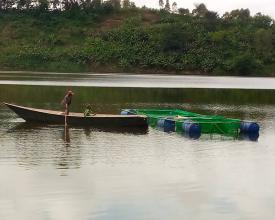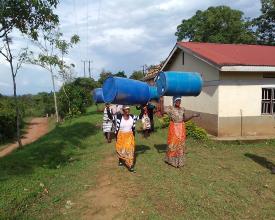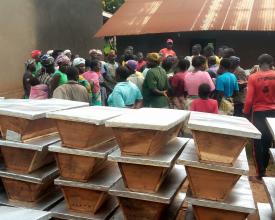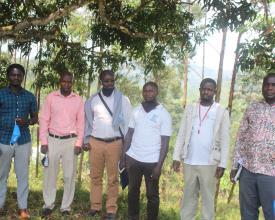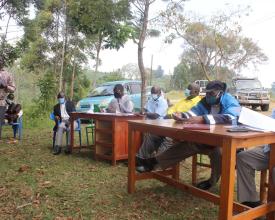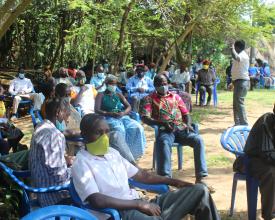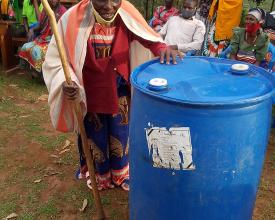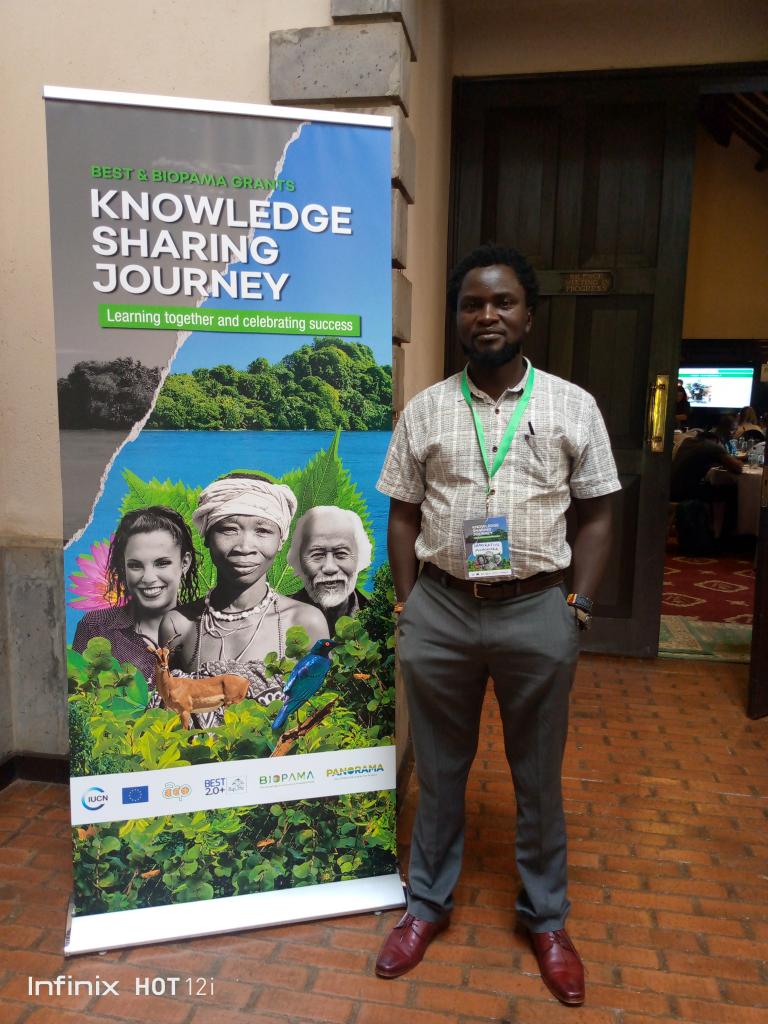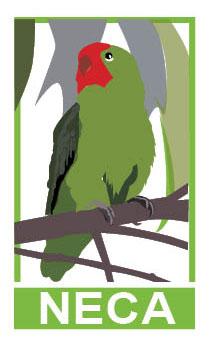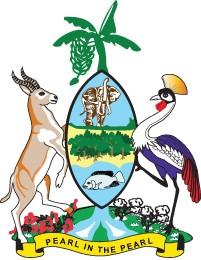
Mejorar los medios de subsistencia socioeconómicos de las comunidades locales para fomentar la restauración/regeneración de los humedales y el uso sostenible de los recursos naturales en el humedal comunitario de Nzuguto.
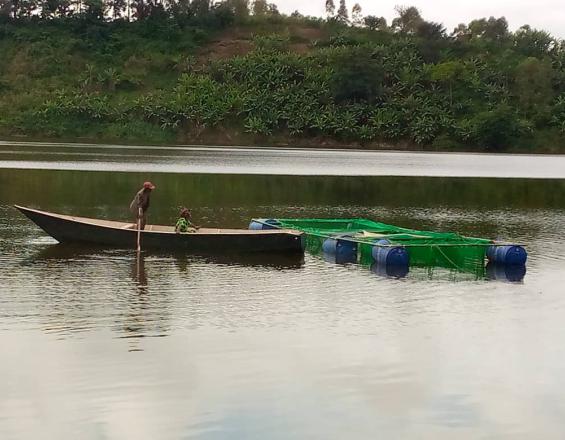
El sistema de humedales de Nzuguto, con una superficie estimada de 56,6 hectáreas, es el mayor depósito de agua, así como una cuenca de captación para los arroyos que drenan desde el lago Mugogo y Nkugute, en el sur, y la reserva forestal de Katsyoha-Kitomi, en el este. La gestión está encomendada al gobierno local junto con las comunidades de acogida. Estratégicamente situado en medio de varias aldeas, el humedal se ha visto amenazado por un acceso no regulado que ha hecho que el 90% de su zona de amortiguamiento se haya destinado a la agricultura, la forestación y la fabricación de ladrillos, lo que ha provocado la pérdida de vegetación, suelo y agua, así como la mala calidad del agua, creando un entorno insalubre incapaz de sustentar la vida silvestre que alberga. Con una subvención de la UICN, financiada por la UE, en el marco del componente de acción BIOPAMA, el GL del distrito de Rubirizi puso en marcha un proyecto que promovía la mejora de los medios de subsistencia de las comunidades de acogida, al tiempo que potenciaba la regeneración natural y la restauración del humedal de Nzuguto mediante el compromiso y el apoyo a nivel familiar e individual.
Contexto
Défis à relever
- Actividad humana incontrolada; recolección de materiales artesanales, extracción de leña, recogida de postes y troncos para la construcción, quema de carbón, pesca, caza furtiva, invasión con fines agrícolas, quemas incontroladas, etc.
- Pérdida de agua debido a las malas prácticas agrícolas en los bordes de los humedales, que se recuperan para el cultivo, la forestación y la colocación de ladrillos.
- Recolección excesiva de productos del humedal como el papiro
- Reducción de las especies arbóreas autóctonas
- Amenazas a los hábitats de cría de la grulla coronada gris debido a los constantes incendios, ya que el humedal es un hábitat de cría primordial para la especie.
- Malas prácticas agrícolas, ya que el uso de pesticidas y fertilizantes ha alterado la calidad del agua
- Alteración del ciclo del agua y del drenaje
- Aumento de alimañas y animales problemáticos como los monos debido a la destrucción de sus hábitats
- Pobreza extrema en la zona debido al desempleo y a la falta de alternativas para generar ingresos.
- Aumento de las enfermedades y la desnutrición debido a un entorno insalubre
Ubicación
Procesar
Resumen del proceso
La búsqueda de la aprobación política de todas las iniciativas de la estructura de gobierno es crucial para el éxito de cualquier proyecto gubernamental. Por eso fue el primer paso del proceso.
Contar con los puntos de vista y opiniones del público en general, además de presentarles una nueva iniciativa en su comunidad, combinada con la formación y educación necesarias, también forman parte del éxito de la ejecución del proyecto. Así pues, todos los componentes están conectados, ya que representan el ciclo de ejecución del proyecto.
Bloques de construcción
Participación de los agentes políticos y del personal técnico
Esto ayuda a orientar y presentar la idea del proyecto a los funcionarios pertinentes que trabajan con el distrito/los administradores directa o indirectamente implicados en el proyecto. Con ello se pretendía evitar futuras consultas de auditoría o conflictos derivados de la ejecución de las actividades. Se trataba de concejales, presidentes de consejos locales o aldeas, líderes políticos de distrito, policía medioambiental, organizaciones de seguridad interna, funcionarios de la administración de distrito, personal técnico de distrito de distintos departamentos (finanzas, adquisiciones, recursos naturales, desarrollo comunitario, ingeniería, etc.). Esto incluía a otras partes interesadas del sector privado que realizaban proyectos más o menos similares, propietarios de alojamientos, etc. Se organizó una actividad de lanzamiento del proyecto o ceremonia de colocación de la primera piedra para informarles de las actividades previstas, los lugares y zonas, el presupuesto, los beneficiarios, los riesgos potenciales y los resultados esperados, además de solicitar su aportación y apoyo para el éxito del proyecto. También se realizaron visitas sobre el terreno para conocer la situación antes de la ejecución.
Factores facilitadores
- Conocimiento del alcance del proyecto, fronteras políticas y administración, ámbito de trabajo de todos los agentes políticos y técnicos y su relevancia en la ejecución de los proyectos.
- Modo de comunicación y capacidad de llegar a ellos - comunicación oficial por escrito invitando a los dirigentes y funcionarios al acto.
- Fondos presupuestados en el proyecto para facilitar dietas/reembolso de transporte/visitas sobre el terreno.
Lección aprendida
- Algunos de los líderes del consejo local son agricultores y se descubrió que están llevando a cabo actividades en el humedal, por lo que no tardaron en aceptar las actividades previstas del proyecto y mostraron la voluntad de ofrecer asesoramiento personal.
- Esto demostró la buena práctica de conceptualización general de la idea del proyecto por parte de los interesados implicados.
- En esta ocasión no se invitó a los miembros de la comunidad de beneficiarios previstos. Esto se hizo en otra ocasión, aunque habría ahorrado tiempo y recursos contar también con ellos en esta ocasión para ayudarles a prepararse para los talleres de sensibilización y educación que tenían por delante.
Sensibilización de los beneficiarios potenciales y de las personas afectadas
El objetivo era reunir a todas las personas afectadas, a los beneficiarios potenciales y a todos los miembros de la comunidad interesados, socios para presentarles la idea del proyecto, sus repercusiones previstas, tanto negativas como positivas, al tiempo que se explicaba a los miembros de la comunidad su papel durante la ejecución. También se pretendía recabar las distintas opiniones e ideas de los miembros para contribuir al éxito de la ejecución de las actividades del proyecto. También se pretendía compartir con los miembros de la comunidad los conocimientos pertinentes necesarios para utilizar el humedal y sus diversos recursos/productos de forma sostenible a fin de vivir en armonía con la naturaleza. El compromiso implicaba enseñar a los miembros la necesidad de su participación en cada paso de la ejecución. Diferentes personas u hogares se dedicaban a distintas actividades en el humedal. En esta reunión de sensibilización se estudió más a fondo cómo se puede llevar a cabo cada actividad en el humedal para minimizar los impactos negativos y maximizar los impactos positivos tanto económica como medioambientalmente. La convocatoria de una reunión comunitaria se anunció en la radio, en las reuniones de la iglesia y en otros medios de comunicación. Esta fue una actividad continua durante toda la ejecución del proyecto.
Factores facilitadores
- En el presupuesto de la subvención se tuvieron en cuenta los gastos de comunicación, además de la celebración de reuniones de sensibilización masiva; se ofrecieron refrigerios.
- La capacidad de llegar a todos los miembros de la comunidad a través de los líderes de los consejos locales, las reuniones multitudinarias, incluido el acto inicial de lanzamiento del proyecto, que se utilizó como otra plataforma para transmitir la información.
- La voluntad de la mayoría de los miembros de la comunidad de conservar los recursos naturales, especialmente de los que ya estaban organizados en la organización comunitaria de conservación del medio ambiente.
Lección aprendida
- Algunos miembros asistieron a la reunión por curiosidad, sabiendo que las actividades del proyecto podrían repercutir negativamente en sus actividades en el humedal, ya que se dedicaban a actividades ilegales y destructivas.
- Al principio, las expectativas eran muy bajas, pero el ánimo fue cambiando gradualmente tras conocer los diversos beneficios que traía consigo el proyecto, incluidas las fuentes de ingresos alternativas.
Educación y formación de los beneficiarios directos
- El objetivo era impartir conocimientos prácticos a los beneficiarios en función de las actividades desarrolladas. Se tuvo en cuenta tanto a los profesionales de la acuicultura, la apicultura, etc., como a los nuevos. Se impartió formación a particulares, familias y grupos/asociaciones de miembros en las categorías de pesca, desarrollo apícola y cultivo de cosechas.
- Esto ayudó a los miembros a saber lo que les espera, cómo planificarlo y gestionarlo de forma sostenible para mejorar sus medios de subsistencia.
- La educación y la formación fueron un proceso continuo durante todo el ciclo de ejecución del proyecto.
Factores facilitadores
- El equipo técnico del proyecto contaba con expertos o funcionarios en las áreas/campos respectivos, a saber, el entomólogo para los proyectos de desarrollo de colmenares, el funcionario superior de agricultura para los cultivadores y el funcionario de pesca para los proyectos de acuicultura.
- El presupuesto de la subvención había facilitado secciones de estas formaciones.
- Ya existían grupos organizados e individuos en las respectivas categorías y algunos miembros ya estaban implicados en empresas como la acuicultura y el desarrollo de colmenares.
Lección aprendida
- Algunos miembros asistieron a la reunión por curiosidad, sabiendo que las actividades del proyecto podrían repercutir negativamente en sus actividades en el humedal, ya que se dedicaban a actividades ilegales y destructivas.
- Las expectativas en términos al principio eran muy bajas, y el estado de ánimo cambió gradualmente tras conocer los diversos beneficios que traía consigo el proyecto, incluidas las fuentes de ingresos alternativas.
- Hubo un número considerable de personas que mostraron interés en unirse a grupos si los había o simplemente compartir los beneficios a título individual.
Satisfacción de las necesidades básicas y alternativas generadoras de ingresos
Este elemento básico aporta beneficios tangibles del proyecto a los beneficiarios directos. Las necesidades básicas de los hogares, como las cocinas de bajo consumo, los dispositivos de recogida de agua de lluvia y los manantiales protegidos, pretendían reducir el acceso y la presión sobre el humedal y sus recursos. Los artículos generadores de ingresos alternativos, como jaulas y estanques para peces o colmenas, estaban destinados a ayudar a las personas, hogares, grupos o asociaciones a mejorar sus medios de vida económicos, con el fin de pasar de la extracción de recursos del humedal con fines comerciales a la extracción exclusivamente para uso doméstico.
Esto implicó un proceso de identificación/selección de beneficiarios directos, en forma de individuos, hogares, grupos o asociaciones, que se llevó a cabo con la ayuda de los líderes de los consejos locales y las listas de asistencia de los miembros que asistieron a varios talleres de sensibilización y educación. Los líderes de los consejos locales ayudaron sobre todo a identificar los hogares vulnerables o marginados, como los discapacitados, los ancianos, los jóvenes pobres y las mujeres.
Factores facilitadores
- El presupuesto de la subvención incluía todos los suministros.
Lección aprendida
- Nunca había suficiente para cubrir a todos los miembros de los pueblos.
Impactos
Las actividades del proyecto han reducido significativamente la invasión, especialmente por parte de los miembros que poseen tierras de cultivo en el borde del humedal, gracias a las diferentes intervenciones y compromisos durante la ejecución del proyecto. Se ha producido un encomiable cambio de actitud y mentalidad de la población local hacia la conservación de los recursos naturales de su comunidad. Ello ha sido posible gracias a las oportunidades que ha brindado el proyecto, como el empleo directo de mano de obra ocasional, los proyectos de colmenares y pesca, la capacitación de la comunidad para poseer y gestionar sus propios recursos para las generaciones futuras, la distribución de artículos domésticos básicos, el acceso al agua potable a través de los manantiales protegidos, etc. Cerca de 200 hogares se han beneficiado de todo ello. Esto se ha manifestado además en un sentimiento de orgullo, pertenencia y autoestima evidente entre las mujeres y los jóvenes locales, que elogian el impacto del proyecto BIOPAMA en su zona, especialmente gracias a la creación de un comité de gestión de los humedales entre los miembros de la comunidad.
Desde la puesta en marcha del proyecto, la regeneración de la vegetación, especialmente en el humedal, es visible y evidente, en comparación con los dos últimos años, debido a la reducción del acceso de la población local.
Beneficiarios
- Beneficiarios directos: más de 170 explotaciones familiares que suman aproximadamente 1.000 personas.
- Asociación de Pescadores de Kamweru ASOCIACIÓN DE 35 MIEMBROS
- Asociación de Piscicultores de Nzuguto 10 MIEMBROS
- Asociación de apicultores de Nzuguto 16 MIEMBROS
Historia
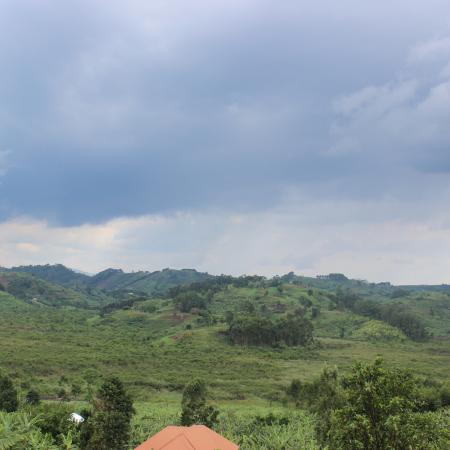
A mediados de los 80, sólo teníamos dos fuentes de agua en nuestro pueblo. Una, el agua del grifo de la comunidad, que fluía por gravedad, y otra, una fuente natural en el humedal de Nzuguto. El agua del grifo era poco fiable, especialmente durante la estación seca. A diferencia de la fuente del humedal de Nzuguto, que era permanente durante todo el año, con charcas permanentes, riachuelos que entraban y salían. La vegetación era impenetrable, con muchas especies diferentes de árboles, hierbas, secciones de papiro, palmeras, plantas silvestres de jengibre, etc. También había varias especies de animales como monos colobos blancos y negros, monos vervet, sitatungas, mangostas, gatos gineta; reptiles como pitones de roca, peces y varias especies de aves.
La población humana era baja en aquella época, y todo el mundo se abría paso en el humedal, recolectando todo lo que podía para uso doméstico sin causar ninguna amenaza.
Entre mediados de los 90 y principios de los 2000, surgieron en el humedal nuevas actividades humanas como la quema de carbón con fines comerciales, la recogida de leña y la colocación de ladrillos. La caza de antílopes y otros mamíferos se intensificó y también aumentaron las actividades agrícolas para ampliar las tierras cultivables. Los incendios constantes para desbrozar la maleza y facilitar el acceso se hicieron cada vez más frecuentes.
Hacia mediados de la década de 2000 desaparecieron monos como los colobos y los sitatungas; la zona de amortiguación de los humedales empezó a reducirse y se talaron grandes árboles. Como resultado, a finales de 2019 empezamos a experimentar escasez de agua en el humedal. Los arroyos y ríos permanentes empezaron a secarse en la estación seca. La situación siguió empeorando y afectó al cercano lago del cráter cuya fuente procede del humedal.
Hasta 2015, me uní a una organización comunitaria denominada Asociación para la Conservación del Medio Ambiente, cuyo objetivo era mejorar los medios de vida de la población local al tiempo que se conservaba el medio ambiente, con el humedal de Nzuguto como principal foco de atención. Me uní y sensibilicé a los miembros sobre el uso sostenible del humedal, introduje actividades de ecoturismo creando senderos turísticos en el humedal, motivé a los miembros presionando para conseguir apoyo de los turistas.
Por primera vez, vi una regeneración natural de los hábitats, una comunidad motivada; hasta 2020, cuando el Bloqueo Pandémico COVID -19 lo fijó. Las comunidades recurrieron a un modo de vida basado en los recursos naturales y el humedal experimentó su destrucción histórica.
Gracias a la Subvención de Respuesta Rápida de BIOPAMA, ¡estamos registrando un gran éxito en la restauración de este gran hábitat!

